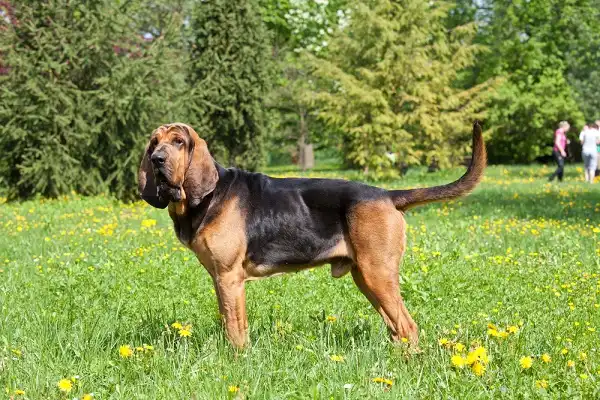There’s nothing better than the thrill of a good hunt. Especially when it involves one of the best breeds in the field, the Bloodhound. With their strong nose and exceptional tracking abilities, these amazing dogs have been used for centuries to search for the game or even lost humans. If you’re looking for an effective hunting companion or just want to learn more about this incredible breed of dog, then look no further – we’ll tell you all that you need to know about Bloodhounds!

Bloodhound Description
Bloodhounds are a breed of dog that has been bred specifically for hunting. They are recognizable by their long, floppy ears and deep-set wrinkles around their face. Bloodhounds have an incredibly powerful sense of smell, considered one of the best tracking breeds in the world. These dogs have highly developed scent receptors and their noses can detect even faint odors over long distances. They also have strong determination, focus, and stamina which make them ideal for long hunts. Bloodhounds come in several colors, including black and tan as well as red and white. Their coats are often wiry and coarse to the touch but surprisingly soft when cared for properly.
Bloodhound Habitat
Bloodhounds are extremely well-adapted to a variety of habitats and climates. They originated in Europe, where they have been used for hunting purposes since the Middle Ages. Their original habitat was deep forests, but today they can be found living in rural and urban settings alike. Bloodhounds can tolerate hot weather better than many other breeds due to their thick coat and natural body chemistry which helps them regulate their internal temperature. They also thrive in colder climates and can live outdoors without special accommodations as long as they have access to shelter from the elements. Bloodhounds can adapt quickly to new environments, making them an ideal choice for hunting expeditions or other activities that require them to travel often. Additionally, they do not require much in terms of care or maintenance and typically do well with minimal grooming.
Bloodhound Diet
Bloodhounds are generally easy to feed and can thrive on a diet of high-quality dry dog food. They do not require any special diets or supplements, but it is important to take into consideration their size and activity level. Bloodhounds that live fairly active lifestyles should be given food with higher amounts of protein and fat to support their energy needs. Conversely, Bloodhounds that live more sedentary lives should be given food with lower amounts of these nutrients to maintain a healthy weight. It is also important to provide them with plenty of fresh water throughout the day, as they tend to get dehydrated easily due to their thick coats. Fresh fruits and vegetables can also help ensure they get enough vitamins, minerals, and fiber in their diets. Additionally, treats should be given sparingly as Bloodhounds are prone to gaining weight if overfed. Overall, providing a balanced diet for your Bloodhound will ensure they stay happy and healthy for many years to come!

Bloodhound Size
Bloodhounds are typically a medium to large-sized breed. Males can reach up to 27 inches in height and weigh up to 90 pounds while females are usually slightly smaller, reaching a maximum of 24 inches tall and 70 pounds in weight. However, these dogs do not require large living spaces as their size is often deceiving due to their deep chests and long, lanky legs. They are surprisingly agile and quick despite their size, able to traverse rough terrain with ease. Bloodhounds also have thick coats that help keep them cool in hot weather but also make them prone to overheating if they become too active or do not receive enough water throughout the day. Additionally, the fur around their face is tightly curled which contributes to their iconic look as well as provides extra protection from the elements when hunting outdoors.
Bloodhound Lifespan
Bloodhounds typically have a life expectancy of between 10 and 12 years, with some individuals living up to 14 years or more. On average, these dogs are considered adults by the age of two and can begin participating in activities such as tracking, scenting, or agility. With proper care and nutrition, Bloodhounds can stay active and healthy throughout their lifetime. They are generally hearty breeds that require minimal medical care, however, they are still prone to common dog ailments such as hip dysplasia and ear infections. Additionally, due to their thick coat, they require regular grooming to prevent matting and excessive shedding. If given ample exercise, socialization opportunities, and love, Bloodhounds can provide companionship for many years to come.
Bloodhound Behavior
Bloodhounds are typically very calm and gentle dogs that can be quite independent. They are highly intelligent and easily trainable, making them an ideal breed for those looking for a loyal companion. Despite their mild-mannered nature, Bloodhounds have an incredible sense of smell that is unmatched by any other breed. As a result, they can be quite determined and persistent when it comes to tracking a scent, making them excellent hunters as well as watchdogs. Bloodhounds also tend to bond closely with their owners and are often described as being very affectionate. When raised correctly, Bloodhounds make wonderful family pets that demonstrate patience and loyalty towards everyone in the household. Additionally, these dogs usually get along well with other animals due to their friendly demeanor and low aggression levels. All in all, Bloodhounds are incredibly smart, loving animals that make great companions for all types of households!

Bloodhound Speed
Bloodhounds are surprisingly fast dogs, capable of reaching speeds of up to 30 miles per hour! This is mainly due to their long, slender legs and powerful muscles. Their coats help them stay cool in hot weather and their long ears aid in aerodynamic efficiency while running. Furthermore, the weight of a Bloodhound can be deceiving; they may appear bulky but are surprisingly light on their feet. As a result, they can sprint very quickly and cover great distances in short amounts of time. All in all, Bloodhounds can reach remarkable speeds and are easily able to keep up with other agile dogs such as Greyhounds or Huskies when running. Additionally, their hunting instincts can help them hone in on a particular scent for miles at a time without tiring out. In this sense, Bloodhounds prove themselves invaluable assets when it comes to tracking down lost animals or people due to their excellent speed and heightened sense of smell.
Bloodhound Hunting
Bloodhounds have been used for hunting and tracking purposes since ancient times. With their incredible sense of smell and unrivaled speed, these dogs can quickly locate a target with ease. In particular, their keen noses are capable of detecting scents that are up to several days old, making them ideal for longer or more complex hunts. Furthermore, they have the strength and agility to pursue their quarry over rough terrain or through thick foliage, allowing them to access areas that humans may not be able to reach. Additionally, Bloodhounds make excellent watchdogs as they are very alert and protective of their owners. They can easily distinguish between friend and foe, making them an invaluable asset in any hunting party. When it comes to tracking specific game animals such as deer or rabbits, Bloodhounds excel in this area due to their impressive senses and ability to follow a scent for long distances. As a result, hunters can use these dogs effectively as a tool for locating elusive prey in remote areas. Furthermore, Bloodhounds also have the capability of accurately distinguishing between different animal scents to select the right target species during the hunt. This makes them invaluable companions when out in the field looking for game animals. All in all, Bloodhounds are amazing hunting partners that bring unparalleled skill sets which make them highly sought after by experienced hunters around the world!

Conclusion
Bloodhounds are a versatile breed that can be used in a variety of ways. From hunting and tracking to family pets, these dogs have an impressive range of skills that make them incredibly valuable companions. Their excellent sense of smell and speed make them invaluable when it comes to finding lost people or game animals in the wilderness, while their friendly demeanor makes them ideal for all types of households. All in all, Bloodhounds are remarkable animals that bring unparalleled skill sets to a wide array of activities!
Frequently Asked Question


